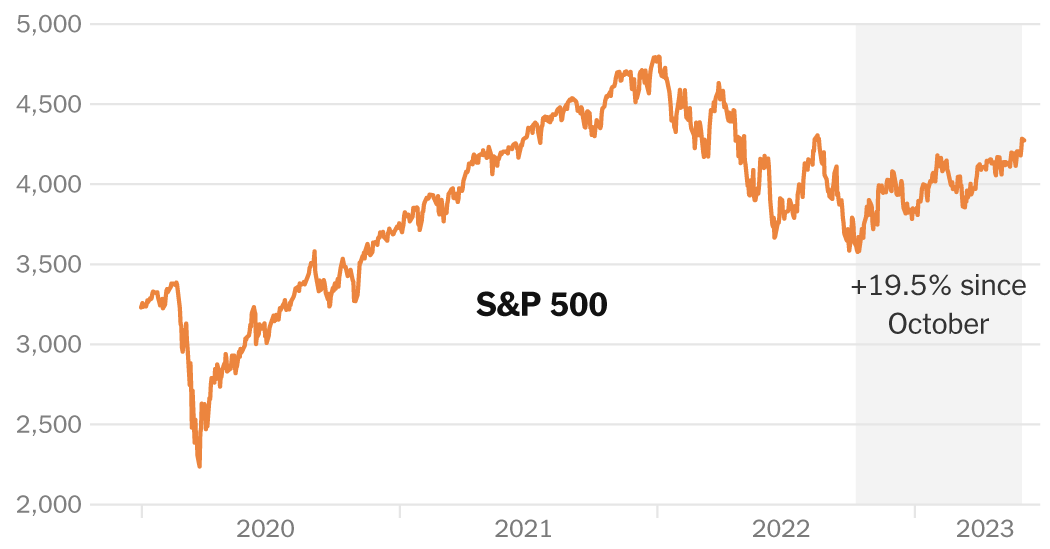The S&P 500, the index obsessed with investors, executives and government officials, ended Monday nearly 20 percent above its 2022 low, a gain some on Wall Street see as the start of a bull market and a new phase of investing exuberance.
The index hovered around the threshold on Monday, rising above it several times before finishing 0.2 percent lower for the day, taking it to 19.5 percent above its October low.
Still, the move underscores the stock market’s strong recovery, as fears of high inflation, rising interest rates and a looming recession had pushed the index steadily down from its peak in early 2022. The S&P 500 entered a bear market – which is defined as a drop of 20 percent or more from an index’s high – in June of that year, and continued to fall to its low in October.
The terms “bull” and “bear” are shorthand for investor excitement or fear about the outlook for publicly traded companies. But while investors often agree on how to mark the start of a bear market, there is less consensus on how to define the start of a bull market, especially when the concerns that initially drove stocks down still linger.
A rule of thumb is that a new bull market is confirmed when an index reaches a new high after rising from a bear market low. By that measure, the S&P 500 is still more than 10 percent short.
But some investors say it’s easier to treat any gain of 20 percent or more in a broad index like the S&P 500 as a major milestone. with the measurement at the end of the trading day. According to S&P Dow Jones Indices, which manages the index, more than $15 trillion in investment assets are benchmarked or indexed against the S&P 500.
“We’re not in a terrible situation,” said James Masserio, co-head of equity for the Americas at Société Générale. “There are certainly risks of recession, but we have to wait and see how they will manifest themselves in the coming months and next year. So technically this is a bull market.”
Still, a 20 percent rise from a low is, mathematically speaking, less substantial than a 20 percent fall from a high. Other investors prefer an assessment that takes a broader view of investor sentiment, economic growth and market direction.
“If a stock goes from $10 to $5 and then rises to $6, it’s not in another bull market,” said Peter Boockvar, chief investment officer at Bleakley Financial Group. “Defining a bull or bear market, however it’s done, has to be done through a broad view of the market.”
The recent rally in the S&P 500 was led by a small group of technology stocks, driven by enthusiasm about the profit-generating potential of artificial intelligence, especially for those at the center of its development and the production of hardware needed to power it. to conduct. Nvidia, the chipmaker, has come to symbolize this newfound enthusiasm for AI as the semiconductors are used in the technology. The company is up nearly 170 percent this year — gains that have pushed its valuation to nearly $1 trillion.
The average individual stock in the S&P 500 is up less than 3 percent this year, market data through Friday showed, compared to gains of more than 11 percent. percent for the index as a whole. About 90 percent of the index’s rise is due to huge profits for just seven of the largest companies: Amazon, Apple, Meta, Microsoft, Nvidia, Tesla and Alphabet, Google’s parent company.
Apple rose 2.2 percent early Monday afternoon, a brief new high for the company, before ending 0.8 percent lower, weighing on the index.
The S&P 500 also tracks only the largest companies listed in the United States. Smaller companies are generally more exposed to fluctuations in the US economy because larger companies generate a significant portion of their sales abroad.
The Russell 2000 index, which tracks smaller publicly traded companies, has recently posted more modest gains than its large company counterpart. The index fell more than 30 percent from its peak in November 2021 to its low last June. Since then, the index has risen about 9 percent. On Monday, the index fell 1.3 percent after weaker-than-expected economic data on the services sector.
The Nasdaq Composite index, which is heavily focused on big technology companies, is up more than 26 percent this year alone. Still, it remains almost 20 percent below its previous peak, which was reached in late 2021.
“I think the 20 percent rule was easy for people to follow,” said Sameer Samana, a senior global market strategist at Wells Fargo Investment Institute. “Unfortunately, some of these bear market rallies trigger that threshold, which we consider a false signal.”
For many investors, the great returns in the stock market are not reflected in the performance of their portfolios. That’s because fund managers, with so much concern about a possible recession, are largely holding more cash and hedging their positions against the risk of a steep decline, handing gains in favor of greater safety.
Just over 27 percent of Morningstar’s tracked funds benchmarked against the S&P 500 beat the index this year, compared to nearly 52 percent last year and an average of 40 percent since 2000.
Hedge funds and other leveraged investors in particular have built up large bets that the S&P 500 will fall, according to data from the Commodity Futures Trading Commission.
“Everyone has been so defensive,” said Andrew Brenner, head of international fixed income at National Alliance Securities. “There’s a lot of money on the sidelines, so this is actually quite painful for a lot of fund managers.”

